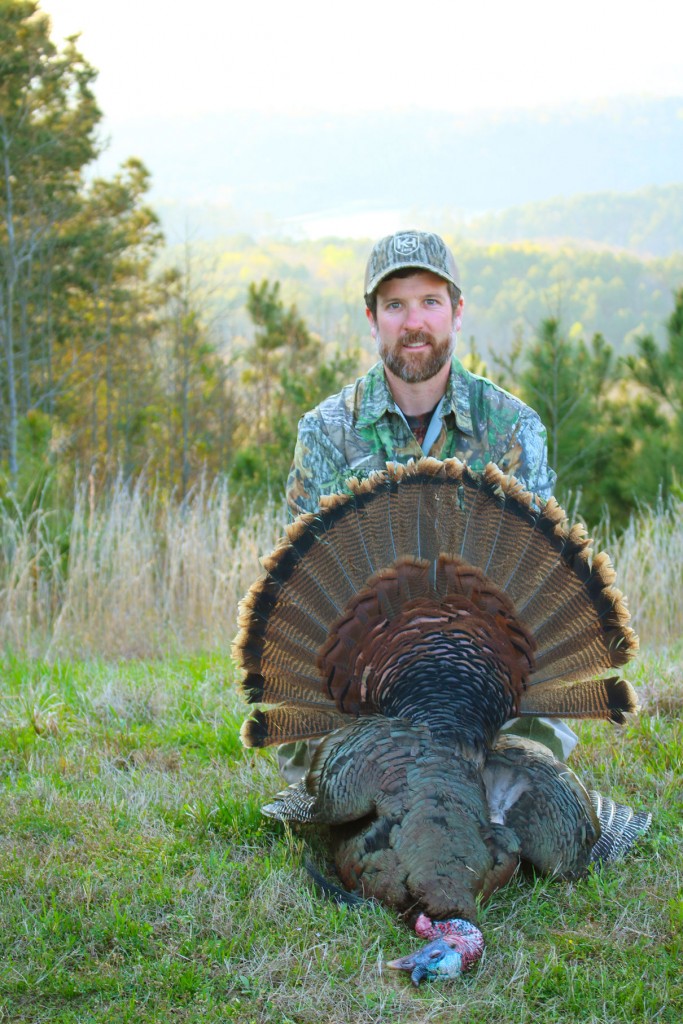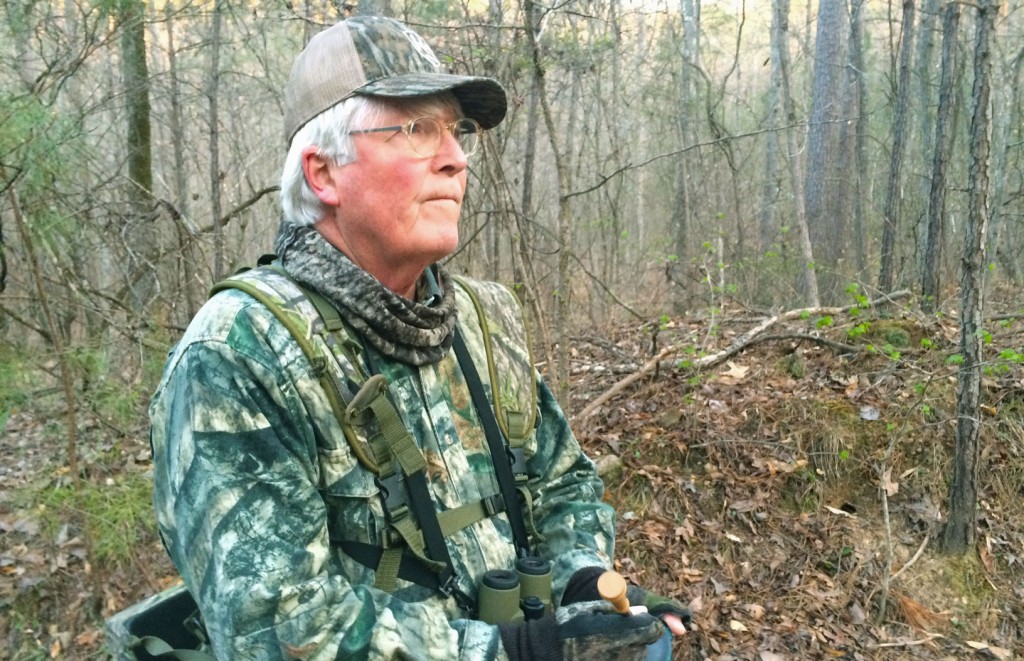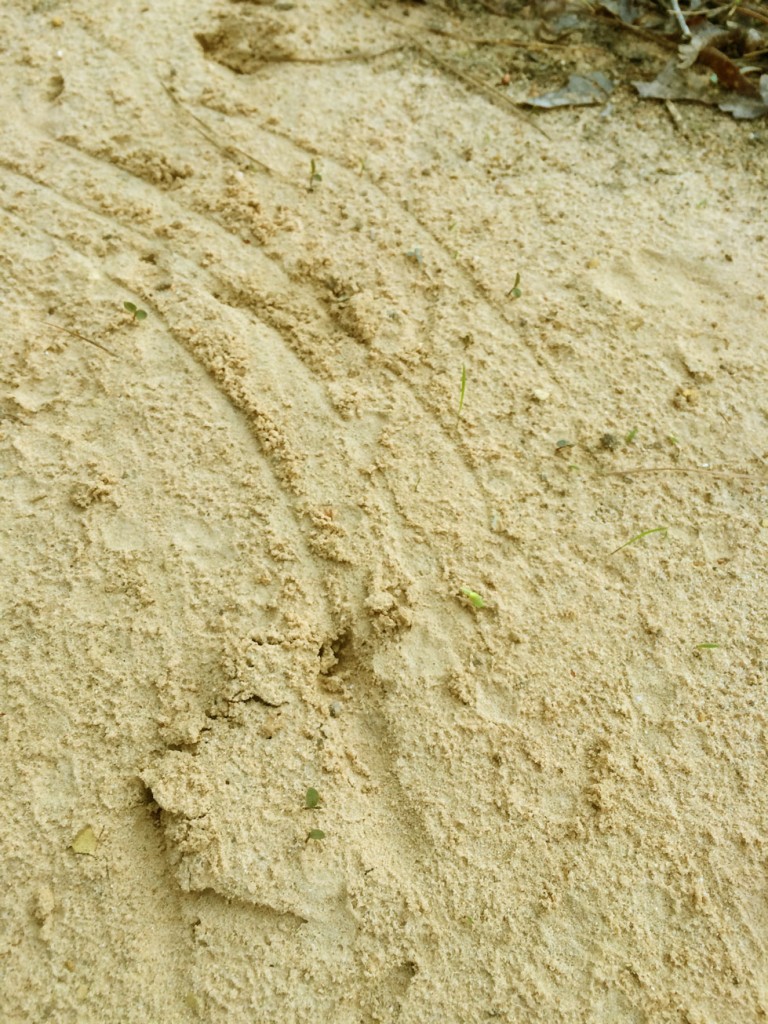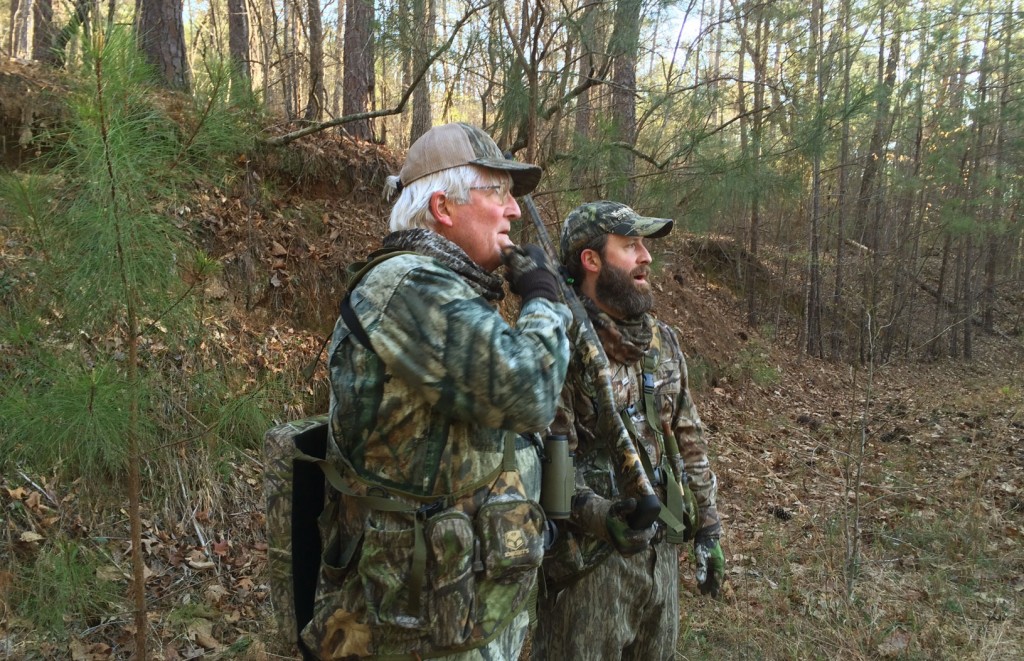As I shake hands with the crowd of camo-clad gentleman standing around at Satterfield Plantation, the introductions are a legendary roll call of turkey-hunting greats.
“Hi, Harold Knight.”
“Hey, David Hale.”
“Chris Parrish.”
“Hey, Mark Prudohmme”
Every introduction represents a level of turkey hunting that most of us are left to only dream about. These legends of the spring are turkey-calling guides for the next three days as we chase turkeys in and around the rocky bluffs, flowing mountain springs and longleaf pine covered ridge tops in the Appalachian foothills of central Alabama.
“Hey Mark, here’s your clothes and stuff over here,” hollers Dan Moultrie. “These guys are ready to get after some turkeys this afternoon. Go on inside and pick any room and get changed.”
You don’t need to tell me twice!
Dan’s last name probably sounds familiar, and it’s one you’ve heard before — if you’re a hardcore hunter. He’s the man who started Moultrie Feeders. His company is well-known for fish and game feeders, game cameras and ATV-food-plot implements. Taking Dan’s advice, I hurry inside to a bathroom. The huge duffle bag is full of Knight and Hale game calls, clothing from 10X, Drake and both Knight and Hale (K&H) and Moultrie. I dress and snatch K&H’s new slate call, the Dual Threat Glass and Slate. It comes with their new Echotech Striker, which features an internal “resonator” to help increase surface contact and make the call sound better.
Back outside I’m paired with legendary owl-calling champ Mark Prudhomme. He directs me toward a truck with Southeastern Pond Management decals on the door. The driver of the truck is Scott Cherones, part-owner of Southeastern Pond Management, a consulting and management company that enhances fishing ponds by making them as productive as they possibly can be. The company’s reputation in Alabama is unrivaled and they manage some of the best fishing lakes in the state. Turns out Cherones owns just under 600 acres in a particularly undulating section of piedmont upland just off the Coosa River in Chilton County. The rugged ridges and valleys are covered in an impressive carpet of mature hardwoods and longleaf pines. It’s a turkey hunter’s paradise.
Transitioning to that afternoon, I find myself sitting most of the way down on a finger ridge extending into a small creek bottom. The creek flows loudly as the gin-clear spring water cascades down the eroded limestone bed to Walnut Creek further below.
Prudohmme pulls out a Scarlet Fever Crystal Glass call and softly purrs and clucks toward the hardwood hillsides. It doesn’t take long before we have a visitor. “I hear something coming up from the creek bottom,” whispers Prudohhme.
A few minutes later a hen materializes on the ridge in front of us. She scratches and pecks for a few minutes and eventually meanders off. An hour later a few hens work their way up the ridge towards our location. My heart skips wildly as I see a bright red head clear the ridge line and walk up the hill to us. I stare and stare at the bird’s chest, but there’s no swinging beard. It’s a yearling Jake. The afternoon wears on and turkeys come and go, but the sun would set over the steep ridges without revealing a mature gobbler.
Day 2
I meet my next guide in a gas-station parking lot at dawn the next morning. His name isn’t widely known among turkey-hunting fanatics, but as the former CEO of one of Alabama’s largest privately-owned businesses — EBSCO — I knew exactly who Dixon Brooke, Jr. was. The company I work for is owned by EBSCO and I remember meeting Dixon a time or two during his final years as CEO. Admittedly, I was apprehensive at first, after all, I used to receive company-wide emails reminding us what the dress code was and to make sure our work areas were tidy prior to Dixon visiting our office. However, it didn’t take long to realize that Dixon was a down-to-earth turkey-hunting junky just like me.
Today, I’m hunting 45 miles north on the outskirts of Alabama’s largest state park — Oak Mountain — on a 2,100-acre tract of land known as The Belcher Property with Dixon and his son Nelson. The property consists of bottomland and two separate tall mountain ridges — Oak Mountain and Double Oak Mountain. The elevation change on the property varies from 1,200 feet above sea level down to 600 feet.
The Belcher Property is a paradise for turkey hunters and nature lovers alike. The towering mature hardwoods and massive longleaf pines are amazing and something that you just don’t see much of anymore. The majority of this property hasn’t been timbered in generations and it shows. Arborists from Clemson University took core samples from a section of towering longleaf pines on a steep secluded ridge and the trees ranged in age from 133 to 188 years old. There’s even cat-faced longleaf pine stumps on the property that bare the scars of the turpentine industry that worked its way through the Southeast during the early 1900s, harvesting sap from the pines. Today, there are federal efforts to incentivize landowners to plant longleaf pines, which are a native pine of the South. Endangered species such as the red-cockaded woodpecker rely on mature longleaf stands for nesting and it’s encouraging to see places where these stands still exists.
Starting off, we slowly work our way through the bottomland section of this beautiful property trying to locate a willing gobbler. The action is slow and the Toms are mute, but this gives Dixon time to unravel the wonders of the Belcher Property. As we walk through the hardwood bottoms he is pointing out native flora, such as wild azaleas, in full bloom. He is also recounting hunts from the past, many of which involved his son Nelson. I’m soaking in the sights, sounds and stories of this area because it’s rare that an EBSCO employee steps foot on this land, let alone hunt turkeys on it, with Dixon. This turkey-hunting paradise is Dixon’s private playground for eastern gobblers. They don’t even hunt deer here and only intrude in the spring to chase strutting Toms. As we pass a cabin known as Belcher Cabin, Dixon tells me stories of sleeping there on weeknights, hunting turkeys in the morning, going back to Belcher cabin to shower, don a suit and tie and drive through the property to perform his CEO duties at EBSCO’s headquarters located off the northeastern corner of the Belcher land.
As lunchtime rolls around, Dixon, Nelson and I haven’t had any luck and Nelson splits off because of a work meeting he must attend. Nelson is a River Keeper on the Black Warrior River in Alabama. He not only advocates for keeping the river wild and clean, but takes and analyzes samples from the watershed to monitor pollution and any other harmful contaminants that might be in the river. As Nelson drives away, Dixon suggests that we take the high ground and head to the towering ridges of Oak and Double Oak Mountain to employ some decoy action on the silent Toms.
Driving up the well maintains gravel road, the view stretches out from the elevation change. The Coosa River Valley, which is some 15 miles away, is visible, as well as distant mountains of the southern tip of the Appalachian ridge. Not only is the terrain steep here, but it’s very rocky and abundant with longleaf pine as well as hardwoods. Dixon reaches in to the back of his truck and pulls out a Pretty Boy decoy, a real turkey fan, a laying hen decoy and a feeding hen decoy. On the ridge top there’s a 300-yard stretch of gravel road that Dixon says the gobblers love to strut on in the middle of the day.
He stakes the decoys down as he instructs me to find a hidden spot in the woods to set up. Once we’re both in place, Dixon begins to scratch on his K&H glass call. He putts, purrs, yelps and clucks for a series or two then puts the call down. Every 10 to 15 minutes Dixon plays another chorus of turkey vocals and sets the call back in his lap. The warm midday sun is shining bright on us and I keep fighting off the strong temptation to close my eyes while listening to the calming breeze blow through the tops of the centennial pines. Even though the action is nil so far this morning, I know a receptive gobbler can quietly sneak in at any moment, so I fight to stay alert.
We finally decide to retreat and grab lunch a few minutes away on one of Birmingham’s busiest stretches of highway, U.S. Highway 280. As a Birmingham native, that’s just one of the aspects of this property that intrigues me so much. Here we are with one of the best views in the metro area, in some of the little remaining virgin timber in the Eastern U.S., and we’re hunting turkeys only 10 miles from downtown Birmingham.
We choose to dine at a local favorite, Jim ’N Nick’s BBQ, but afterward it is back to the high ground for more calling and sitting. Dixon and I keep hunting and keep calling all afternoon. With daylight on the retreat, Dixon says he has one more place to set up. It’s on the ridge of Double Oak Mountain overlooking the southern suburbs of Birmingham, adjacent to Oak Mountain State Park. He says it’s a place where the turkeys seem to gather before flying up to roost for the night. This will be our last stand.
After setting up the Pretty Boy decoy and faux hens on the side of the gravel road, I climb the hillside about 20 yards above the spread and Dixon continues beyond me another 30 yards and plops down against an oak tree. With facemasks pulled up, Dixon again plays a love-song melody of yelps, clucks and purrs.
Eleven hours into the day’s hunt, I sit thankful upon Double Oak Mountain, absorbing the view from my ridge-top perch. The various green hues projecting from the newly emerging leaves below are a welcoming sign of renewal after a long winter. I’m grateful for the new friends I’ve made in Dixon and Nelson Brooke, too. It’s funny how a day of turkey hunting can make strangers feel as if they’ve known each other for years. Perhaps this type of bond was formed thousands of years earlier during the advancement of our primitive ancestors. Maybe when two or more take part in the ancient craft of pursuing game the hunter’s heart merely confirms that bond.
Peacefully sitting there, I already accept the wild turkey had won the battle of survival today. Sure, I might not go hungry tonight thanks to modern conveniences, but instincts are hardwired and my mind was already consoling my body for the lack of fresh protein that I won’t be getting.
Suddenly, I snap from my meditative state as I hear the unmistakable crunch of dry leaves. I hear it again, and now with a definitive cadence — footsteps! The sound emanates from the ridge top behind me and to my left. With my gun in my lap, I slowly turn my head while glaring my eyes as far left in my eye socket as they’ll go. I can feel my veins throb in my head as my heart beats wildliy. The steps are getting closer, and then I see the bright red head of a gobbler. The black-bodied bird continues its path down the hill toward the road. He cranes his neck high in the air, turning his head sideways when he sees the decoy spread 40 yards below him. He pulls his head close to his body and puffs into a strut. He pops out of strut and continues angling toward the decoys in front of me. He disappears behind a tree for a split second then pops out on the other side and struts again. Again, he comes out of strut and walks towards the decoys below. As the Tom gets within 20 yards of the decoys he pauses behind a tree for about 10 seconds. I hear his footsteps again, and this time he emerges from behind the mature oak tree and begins heading directly back the way he came. He didn’t like what he saw on closer examination.
Now feeling the weight of urgency as the bird retreats, I start asking myself questions, such as, “When do I lift my shotgun?” Then I remember the one tree he crossed behind while directly to my left. Each step puts him closer to that climactic point of this survival story. Then, his brilliant red head disappears. I quickly raise the same black Remington 11-87 Special Purpose shotgun that I raised 19 years earlier to kill my first gobbler. I shoulder it with muscle memory and wait for his emergence. It seems like slow motion as the gobbler’s head materializes from behind the tree and looks directly at me some 35 yards away. He can tell the landscape has shifted, but I’m already drawing a bead on the base of the bird’s neck. It’s too late for him to change course now and the Tom crumples at the roar of the blast.

The sunsets are spectacular from atop Double Oak Mountain...and the turkey hunting is pretty good, too!
I quickly run over to my hard-earned reward. I pounce on the still flopping Tom as Dixon comes running off the hillside toward me. We celebrate with high fives and hugs. We are rejoicing in the victory of the day-long hunt. Though the the suburbs of Birmingham sprawl out before our eyes, only Dixon and I know of the patience and success that transpires on Double Oak Mountain. Sometimes, luck really does favor the prepared.









